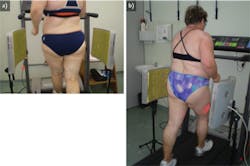LED light exposure during exercise could reduce osteoporosis, eliminate cellulite
Researchers from the Optics Group of the Federal University of São Carlos at the University of São Paulo (São Paulo, Brazil) found that shining LED light on a woman's legs while she exercises on a treadmill could help reduce the risk of osteoporosis and, by the way, banish cellulite.1 The technique is promising for several groups, too: Those with neural disorders; astronauts; those who are aging or obese; people with cardiovascular and respiratory diseases; and athletes who want to improve their physical performance.
The one-year study looked at 20 post-menopausal women who weren't taking hormone replacement therapy or suffering from other medical conditions. They were divided into two groups of 10: The first group exercised on a treadmill twice a week for 45 minutes while being exposed to infrared (IR) light, while the second group followed the same exercise regimen without the light.
Two aluminium plates, each containing an array of 2,000 LEDs, were fitted to each side of a treadmill (see figure). The arrays enabled large, uniform irradiation of the hip and quadriceps muscles, lead researcher Fernanda Rossi Paolillo told BioOptics World. These body parts are areas where there is incidence of osteoporosis, mainly at the femur, as well as localized fat deposits and cellulite, she says.
LEDs have a low operational cost and allow irradiation of larger areas, with absorption of photons by several chromophores due to their broad range of wavelengths.
In the first trial, explains Paolillo, the research team chose the applied dose of LED light based on typical doses used in regular practice (around 60 J/cm2). In a subsequent trial, they chose an optimal dose (around 100 J/cm2), which resulted in much more accentuated photobiomodulatory (the effect of low-level light) effects in muscle and bone, she says.
The research showed that women in the group who had exercised regularly without LED exposure had lost significant mass (2.5 percent) in the thigh bone over the study period, while those who exercised with the light exposure did not have any bone loss. The dynamic mechanic stimulation achieved by the LEDs is efficient for muscle performance and bone formation by piezoelectric effect (internal generation of electrical charge resulting from an applied mechanical force).
1. F.R. Paolillo et al, J. Cosmet. Laser. Ther., 3, 4, 166-71 (August 2011).
More BioOptics World Current Issue Articles
More BioOptics World Archives Issue Articles

